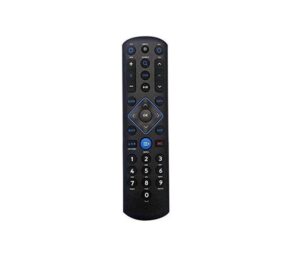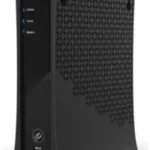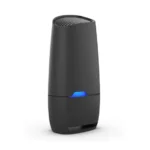The Spectrum remote control allows you to operate your TV, DVR and CABLE BOX from the comfort of your couch. This Spectrum user guide will teach you how to use the features on the screen so that you can enjoy your favorite shows in style.
Manufactured by Spectrum
Getting Started
Install Batteries
- Apply pressure with your thumb and slide the battery door for removal Show image of bottom of remote, indicating pressure point and slide direction
- Insert 2 AA batteries. Match the + and – marks. Show illustration of batteries in place
- Slide the battery door back into place. Show bottom of remote with battery door in place, include arrow for slide direction.
Setup Your Remote for a Charter WorldBox
If you have a Charter WorldBox, the remote must be paired with the box. If you do NOT have a WorldBox, proceed to PROGRAMMING YOUR REMOTE FOR ANY OTHER CABLE BOX.
- Ensure that your TV and WorldBox are both powered on and that you can view the video feed from the WorldBox on your TV. Show image of STB and TV connected and on
- To pair the remote, simply point the remote at the WorldBox and press the OK key. The Input key will begin blinking repeatedly. Show image of remote pointed at the TV, transmitting data
- A confirmation message should appear on the TV screen. Follow the on-screen instructions to program the remote control for your TV and/or audio equipment as needed.
If you wish to use the remote with a different cable box, follow these steps to un-pair it with your WorldBox.
- Press and hold MENU and Nav Down keys simultaneously until the INPUT key blinks twice. Show remote with MENU and Nav Down keys highlighted
- Press 9-8-7 digit keys. The INPUT key will blink four times to confirm pairing has been disabled. Show remote digits with 9-8-7 highlighted in order.
Programming Your Remote for Any Other Cable Box
This section is for any cable box that is NOT a Charter WorldBox. If you have a WorldBox, refer to the section above for remote pairing, following the on-screen instructions for any other remote programming.
Point your remote at your cable box and press MENU to test. If the cable box responds, skip this step and proceed to PROGAMMING YOUR REMOTE FOR TV AND AUDIO CONTROL.
- If your cable box is branded Motorola, Arris, or Pace:
- Press and hold MENU and the 2 digit key simultaneously until the INPUT key blinks twice.
Show remote with MENU and 3 keys highlighted
- Press and hold MENU and the 2 digit key simultaneously until the INPUT key blinks twice.
- If your cable box is branded Cisco, Scientific Atlanta, or Samsung:
- Press and hold MENU and the 3 digit key simultaneously until the INPUT key blinks twice.
Show remote with MENU and 3 keys highlighted
- Press and hold MENU and the 3 digit key simultaneously until the INPUT key blinks twice.
Programming Your Remote for TV and Audio Control
This step covers setup for the most common TV brands. If your brand is not listed, please proceed to SETUP USING DIRECT CODE ENTRY
- Ensure that your TV is powered on. Show TV with remote pointed at it.
- Simultaneously press and hold MENU and OK keys on remote until the INPUT key blinks twice. Show remote with MENU and OK keys highlighted
- Find your TV brand in the chart below and note the digit that relates to your TV brand. Press and hold down the digit key.
Digit TV Brand 1 Insignia/Dynex 2 LG/Zenith 3 Panasonic 4 Philips/Magnavox 5 RCA/TCL 6 Samsung 7 Sharp 8 Sony 9 Toshiba 10 Vizio - Release the digit key when the TV turns off. Setup is complete.
Show remote pointed at TV, transmitting data and TV is off
NOTES: While holding the digit key, the remote will test for the working IR code, causing the INPUT key to flash each time it tests a new code.
This step covers setup for all TV and Audio brands. For faster setup, be sure to locate your device brand in the code list before beginning setup.
- Ensure that your TV and/or audio device is powered on.
Show TV with remote pointed at it. - Simultaneously press and hold MENU and OK keys on remote until the INPUT key blinks twice.
Show remote with MENU and OK keys highlighted - Enter the 1st code listed for your brand. The INPUT KEY will blink twice to confirm once complete.
Show remote with digit keys highlighted - Test volume functions. If the device responds as expected, setup is complete. If not, repeat this process using the next code listed for your brand.
Show remote controlling TV.
Assigning Volume Controls
The remote is set to default to control TV volume once the remote is programmed for a TV. If the remote is also set up to control an audio device, then volume controls will default to that audio device.
If you wish to change volume control settings from these defaults, perform the following steps:
- Simultaneously press and hold MENU and OK keys on remote until the INPUT key blinks twice.
Show remote with MENU and OK keys highlighted - Press the key below for the device that you wish to use for volume controls:
- TV Icon = To lock volume controls to the TV, Press VOL +
- Audio Icon = To lock volume controls to the audio device, Press
- VOLCable Box Icon = To lock volume controls to the cable box, Press MUTE.
Troubleshooting
| Problem: | Solution: |
| INPUT key blinks, but remote does not control my equipment. | Follow the programing process in this manual to set your remote up to control your home theater equipment. |
| I want to switch VOLUME CONTROLS from to control my TV or to my Audio Device. | Follow ASSIGNING VOLUME CONTROLS instructions in this document |
| The INPUT key does not light up on the remote when I press a key | Ensure that the batteries are functional and are inserted properly Replace the batteries with two new AA size batteries |
| My remote won’t pair with my Cable Box. | Ensure that you have a Charter WorldBox. Ensure that the remote has a clear line of sight to the Cable Box when pairing. Be sure to follow the on-screen instructions that appear when pairing. |
Remote Key Chart
| TV POWER | Used to turn on the TV |
| INPUT | Used to switch video inputs on your TV |
| ALL POWER | Used to turn on the TV and set-top box |
| VOLUME +/- | Used to change volume level on TV or Audio Device |
| MUTE | Used to mute volume on TV or STB |
| SEARCH | Used to search for TV, Movies, and other content |
| DVR | Used to list your recorded programs |
| PLAY/PAUSE | Used to play and pause current selected content |
| CH +/- | Used to cycle through channels |
| LAST | Used to jump to the previous tuned channel |
| GUIDE | Used to display the program guide |
| INFO | Used to display selected program info |
| NAVIGATION UP, DOWN, LEFT, RIGHT | Used to navigate on-screen content menus |
| OK | Used to select on-screen content |
| BACK | Used to jump to previous menu screen |
| EXIT | Used to exit the current displayed menu |
| OPTIONS | Used to select special options |
| MENU | Used to access main menu |
| REC | Used to record current selected content |
| DIGITS | Used to enter channel numbers |
Declaration of Conformity
Federal Communication Commission Interference Statement
This equipment has been tested and found to comply with the limits for a Class B digital device, pursuant to Part 15 of the FCC Rules. These limits are designed to provide reasonable protection against harmful interference in a residential installation. This equipment generates, uses, and can radiate radio frequency energy and, if not installed and used in accordance with the instructions, may cause harmful interference to radio communications. However, there is no guarantee that interference will not occur in a particular installation. If this equipment does cause harmful interference to radio or television reception, which can be determined by the turning of equipment off and on, the user is encouraged to try to correct the interference by one of the following measures:
- Reorient or relocate the receiving antenna.
- Increase the separation between the equipment and receiver.
- Consult the dealer or an experienced radio/TV technician for help.
- Connect the equipment into an outlet on a circuit different from that to which the receiver is connected.
This device complies with Part 15 of the FCC Rules. Operation is subject to the following two conditions: (1) This device may not cause harmful interference, and (2) this device must accept any interference received, including interference that may cause undesired operation. The user is cautioned t that the changes and modification made to the equipment without the approval of the manufacturer could void the user’s authority to operate this equipment.




